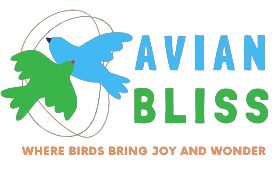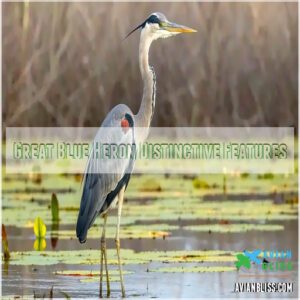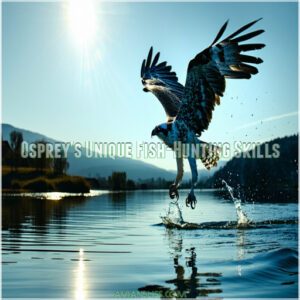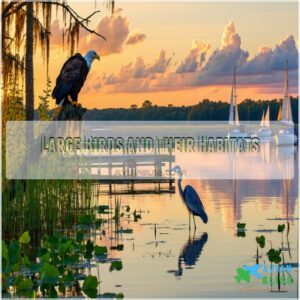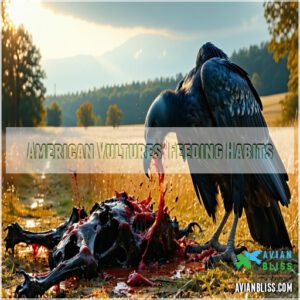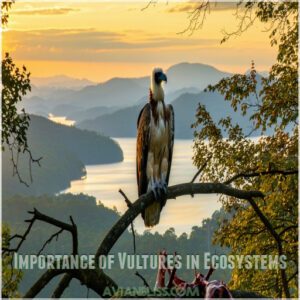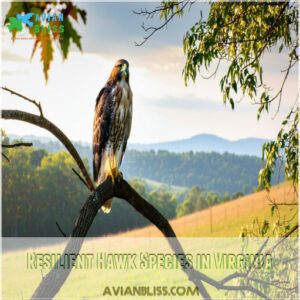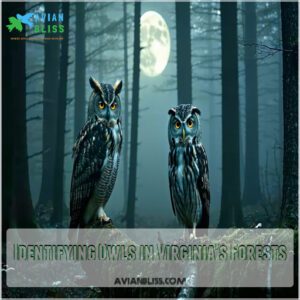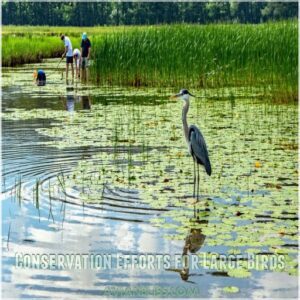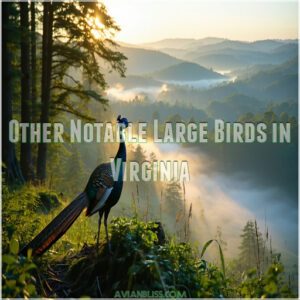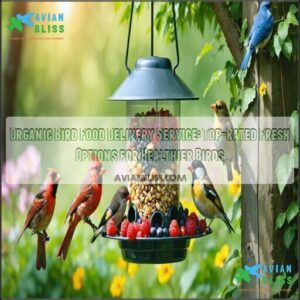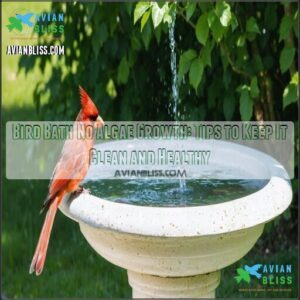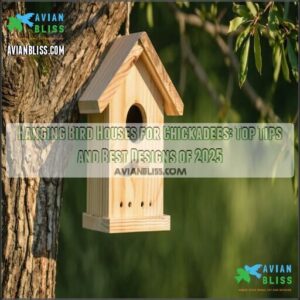This site is supported by our readers. We may earn a commission, at no cost to you, if you purchase through links.
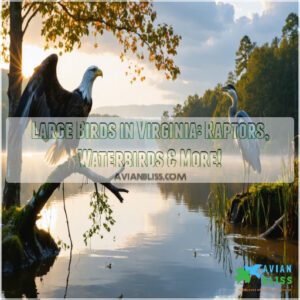 Virginia is home to a diverse array of large birds, from majestic raptors to graceful waterbirds.
Virginia is home to a diverse array of large birds, from majestic raptors to graceful waterbirds.
You might spot the Bald Eagle, with its impressive wingspan, or the cunning Peregrine Falcon, nesting on urban structures.
Keep an eye out for the Great Blue Heron, a stunning, gray-blue bird, and the clever Osprey, a master fisherman.
Virginia’s skies also host the Golden Eagle and Mississippi Kite.
Conservation efforts are essential to protect these birds from habitat loss.
Stay tuned as we explore these magnificent creatures and the challenges they face in Virginia’s changing landscape.
Table Of Contents
- Key Takeaways
- Iconic Birds of Prey in Virginia
- Water Birds Commonly Found in Virginia
- Large Birds and Their Habitats
- Vultures and Their Ecological Role
- Resilient Hawk Species in Virginia
- Identifying Owls in Virginia’s Forests
- Conservation Efforts for Large Birds
- Challenges Facing Virginia’s Birds
- Viewing and Enjoying Large Birds
- Other Notable Large Birds in Virginia
- Frequently Asked Questions (FAQs)
- What is the largest bird in Virginia?
- What are the big gray birds in Virginia?
- What bird has long legs in Virginia?
- How do you identify a hawk in Virginia?
- What is the big bird in Virginia?
- What are the biggest birds in size?
- What is the largest heron in Virginia?
- What seasonal changes affect large birds behaviors?
- How do large birds communicate in Virginias habitats?
- What are the migratory patterns of large Virginia birds?
- Conclusion
Key Takeaways
- Virginia is home to a diverse array of large birds, including majestic birds of prey like the Bald Eagle and graceful waterbirds such as the Great Blue Heron.
- Conservation efforts are crucial to protect these birds from habitat loss, pollution, and the harmful effects of pesticides.
- Birdwatching in Virginia offers the chance to see some of the largest and most impressive birds in the country, with hotspots like Shenandoah National Park and Chincoteague National Wildlife Refuge.
- The state’s large birds, such as the Bald Eagle and the Common Raven, showcase their intelligence and adaptability, whether it’s through unique hunting strategies or social bonding.
Iconic Birds of Prey in Virginia
Virginia is home to a variety of iconic birds of prey, each with unique characteristics and behaviors.
You’ll learn about the majestic Bald Eagle, the powerful Golden Eagle, the agile Peregrine Falcon, and the graceful Mississippi Kite, exploring their habitats, nesting habits, and migration patterns.
Bald Eagle Characteristics and Habitat
Soar above Virginia’s skies and you might spot the majestic bald eagle, a true icon with its brown body, wings, and that famous white head.
These birds are opportunists, feasting on fish, small birds, or even scavenged meals.
- Eagle Eye for Food: Bald eagles are skilled hunters with a preference for fish, but they’ll also scavenge or steal from other birds.
- Home Sweet Home: You’ll find their nests near large bodies of water.
- Conservation Success: Banning DDT has these birds thriving again.
- Threats: Habitat destruction and pollution are still risks.
- Virginia’s Pride: They’re a symbol of freedom and strength, and a sight to behold. For more information on the bald eagle conservation efforts, it’s essential to understand their habitat and behavior.
Golden Eagle Wintering in Virginia
The majestic Golden Eagle graces Virginia’s mountains during winter, a spectacle for bird enthusiasts.
With a preference for mammalian meals, these scarce birds of prey migrate south to feast.
Bird conservation efforts are essential to protect them from habitat loss, ensuring safe birdwatching across Virginia’s landscapes.
Keep an eye out for these majestic birds and appreciate their beauty and role in the ecosystem.
Peregrine Falcon Nesting Habits
The Peregrine Falcon, a star among Virginia bird species, shines in adaptability.
These powerful raptors defy expectations by nesting on artificial structures like bridges and skyscrapers in urban areas, in addition to natural cliffs.
Their success in these unique habitats showcases their resilience and flexibility in bird conservation.
This behavior highlights the importance of understanding falcon nesting preferences and the availability of suitable nesting sites, even in urban environments, for these large birds in Virginia.
The study of virginia birds of prey provides valuable insights into the characteristics and behaviors of these remarkable birds, including their nesting habits and conservation status.
Mississippi Kite Migration Patterns
As summer fades and fall sets in, keep an eye out for the Mississippi Kite—a sleek bird of prey that graces Virginia’s skies during its southbound migration.
These adaptable birds have an affinity for urban areas, putting on a graceful aerial display as they catch cicadas in flight.
Here’s what makes their migration patterns unique:
- They’re urban adapters, feeling right at home in cities.
- Their graceful flight is a sight to behold, with effortless maneuvers that showcase their agility.
- They’re bug hunters, snatching cicadas mid-air for a tasty treat.
- They fly with friends, often accompanied by Broad-winged Hawks on their journey.
- They’re peaceful co-existors, sharing airspace with Red-tailed Hawks without a fuss.
Water Birds Commonly Found in Virginia
Virginia is home to a variety of water birds, each with unique characteristics and behaviors.
You’ll be amazed by the fishing prowess of Ospreys, the graceful flight of Brown Pelicans, and the intriguing behavior of Double-crested Cormorants as they dry their wings.
Great Blue Heron Distinctive Features
The Great Blue Heron is a stately bird, often spotted in Virginia’s wetlands, standing tall with its signature ‘S’ curved neck.
Its hunting style is a demonstration of patience as it stalks fish with slow, deliberate steps.
This solitary bird is often seen motionless, blending seamlessly into its environment.
With a wingspan of up to 79 inches, it’s a true marvel among Virginia’s large waterbirds.
| Feather Patterns | Herons have distinct feather patterns with a mix of gray, blue, and white, creating a stunning visual contrast. |
|---|---|
| Beak Shapes | Their beaks are long, yellow, and sharp, perfectly adapted for hunting fish. |
| Leg Colors | The legs of a Great Blue Heron are a unique shade of grayish-blue, standing tall in the water. |
Osprey’s Unique Fish-Hunting Skills
From wading birds, let’s shift our focus to a unique fish hunter.
The Osprey, a large bird in Virginia, displays remarkable fish hunting tactics.
With 4K bird vision, they spot fish from incredible heights.
These aerial acrobats then execute a dramatic plunge, seizing fish with specialized talons.
The Osprey’s diving for fish techniques are a key aspect of their hunting success.
For ideal bird watching in Virginia:
- Observe their fishing strategies.
- Look for Osprey nesting sites near water.
- Note their reversible outer toes for gripping slippery prey.
- Appreciate Virginia wildlife and this unique bird species.

Brown Pelican Diving Techniques
Brown pelicans are masters of the dramatic, with a spectacular diving strategy that’s nature’s equivalent of a splashy water entry.
These large bird species in Virginia descend from heights, leveraging air sacs to cushion the impact of their plunge.
With a diving height of over 30 feet, they swoop in to capture small fish, showcasing their unique feeding strategy and expertise in plunge-diving.
This essential part of Virginia’s wildlife is a treat for bird watchers and photographers alike, offering a humorous and elegant display of nature’s wonders.
| Diving Mechanics | Feeding Strategies |
|---|---|
| Height | Small fish |
| Air sacs | Plunge-diving |
| Water Entry | |
| Plumage Adaptation | |
| Dive Depth |
Double-crested Cormorant Wing-Drying Behavior
Unlike their pelican peers, Double-crested Cormorants need to frequently dry their feathers.
You’ll often spot them sunbathing with their wings spread wide.
This unique behavior is necessary because, unlike other water birds, Cormorants don’t have water-repellent oils to keep their feathers dry.
Here are four key points to understand this behavior:
- Sun-drying: Cormorants are often seen perched in the sun with their wings spread out.
- No water-repellent oils: Unlike other water birds, Cormorants lack the natural oils that repel water.
- Quick-drying adaptations: Their feathers are designed to dry quickly, helping them return to the water promptly.
- Wing maintenance: This behavior is essential for maintaining healthy feathers and efficient flight.
Large Birds and Their Habitats
Virginia is home to a diverse range of large bird species, each with unique habitat preferences.
From majestic birds of prey to graceful waterbirds, you’ll discover a fascinating variety of avian life across the state’s landscapes, from swamplands to coastal areas.
Habitat Preferences of Great Egret
The Great Egret, a majestic bird, showcases its grace and elegance as it wades through Virginia’s diverse wetlands.
These large birds are skilled hunters, stalking fish, frogs, and small rodents in their aquatic habitats.
Marshes, estuaries, ponds, and reservoirs—the Great Egret adapts to them all, even thriving in human-made environments.
This adaptability is key to their success, allowing them to tolerate human activity and urbanization.
Birdwatchers in Virginia are treated to the sight of these graceful birds drying their wings in the sun or hunting in shallow water.
The Great Egret’s ability to thrive in various habitats, from tranquil marshes to tidal estuaries, showcases the richness of Virginia’s wetland ecology and the resilience of its bird life.
Egret nesting sites vary, from trees and shrubs in natural settings to artificial platforms in more urbanized areas.
This versatility guarantees the Great Egret’s place as a prominent bird species in Virginia.
Understanding their great egret behavior is vital for effective conservation and management of these magnificent creatures.
Swamplands and Ibises in Virginia
Virginia’s swamplands, with their whispering wetlands, are a sanctuary for the elusive glossy ibis.
These wandering birds frequent the Chincoteague National Wildlife Refuge, where they captivate birdwatchers.
Despite habitat threats, conservation efforts and ecotourism support a healthy population.
So, grab your binoculars and venture into Virginia’s swamplands to witness the graceful flight of the glossy ibis.
Discover why these waterbirds are a cherished part of the state’s diverse birdlife.
Tundra Swan Migration and Living Areas
Every year, the tundra swan migrates thousands of miles to Virginia, an awe-inspiring journey.
These majestic birds grace our wetlands, where:
- They feed on rich food sources, forming tight-knit flocks.
- Their migration and habitat patterns are well-defined.
- Bird conservation efforts guarantee their survival.
- Wetland ecosystems play a significant role in their lives.
- Unique swan behaviors can be observed and studied.
Tundra swans truly are a wonder of Virginia’s birdlife, showcasing majestic birds in their natural habitat.
Vultures and Their Ecological Role
American Vultures are nature’s clean-up crew, playing a pivotal role in maintaining healthy ecosystems.
Their unique feeding habits, which involve consuming carrion, contribute to disease control and the recycling of nutrients back into the environment.
American Vultures’ Feeding Habits
Nature’s cleanup crew, vultures play a starring role in maintaining Virginia’s ecosystems.
These masterful scavengers soar the skies, their sharp eyes scanning for decaying animals.
With their acidic stomachs, they safely feast on rotting flesh, a unique ability that prevents disease spread.
Bird watchers in Virginia often spot Black Vultures and Turkey Vultures, nature’s unsung heroes, keeping the environment clean and healthy.
Importance of Vultures in Ecosystems
Vultures: Nature’s Janitors in Virginia
The unsung heroes of the bird world, vultures, play a critical role in maintaining ecosystem balance and human health.
Their scavenger role is key to disease control, preventing the spread of harmful illnesses like anthrax and cholera by efficiently disposing of carcasses.
This unique ecological niche guarantees a safe and clean environment, and their absence would mean an increase in disease-spreading scavengers like feral dogs and rats.
So, the next time you’re birdwatching, appreciate these diligent janitors!
Resilient Hawk Species in Virginia
Virginia is home to several resilient hawk species, each with unique adaptations and hunting styles. You’ll be fascinated by the Red-tailed Hawk’s versatility and the Red-shouldered Hawk’s one-of-a-kind hunting strategy.
Red-tailed Hawk Adaptability
The Red-tailed Hawk is a master of adaptation, thriving in diverse habitats across Virginia.
This common bird is a sight to behold, whether in rural woods or urban settings.
Their success lies in their versatile diet and strategic nesting habits.
Birdwatchers are treated to a display of unique flight patterns during breeding season.
The Red-tailed Hawk’s adaptability is a demonstration of their resilience and a treat for bird enthusiasts.
Red-shouldered Hawk Unique Hunting Style
The red-shouldered hawk, a master of the Virginia skies, employs a unique hunting strategy.
This hawk’s success in forest habitats relies on three key tactics: a preference for amphibian prey, impressive aerial maneuvers, and the element of surprise, dropping directly onto their target.
Birders in Virginia are treated to this species’ distinctive hunting style, adding to the state’s diverse and fascinating birdlife.
Keep an eye out for this resilient hunter and you might just witness its impressive hunting techniques first-hand.
Identifying Owls in Virginia’s Forests
As you explore Virginia’s forests, you’ll encounter two distinctive owl species: the Great Horned Owl and the Barred Owl.
Each has unique features and vocalizations, providing an exciting challenge for bird enthusiasts to identify and differentiate them.
Great Horned Owl’s Distinctive Features
The great horned owl, a stealthy predator, boasts prominent ear tufts and facial disks that frame its sharp vision.
Its distinctive "hoot," resembling a deep laugh, echoes through Virginia’s woods.
This adaptable bird dominates diverse habitats with unparalleled hunting skills.
Its feather patterns provide exceptional camouflage, and its keen night vision and silent flight make it a formidable hunter.
These unique traits make identifying this large Virginia bird a memorable experience.
Barred Owl’s Vocalization Patterns
As you trek through Virginia’s forests, the Barred Owl’s iconic call, "who cooks for you?" rings out, a familiar and entertaining owl sound.
But these owls are more than one-trick ponies; they’re master mimics, able to replicate the whinnying of an Eastern Screech-Owl or the whistling of a Northern Saw-Whet Owl.
- Owl Communication: Barred Owls use distinct calls to mark their territory and attract mates.
- Bird Calls: Their vocalizations include hoots, barks, and the famous "who cooks for you?" call.
- Vocal Learning: These owls showcase advanced vocal learning abilities, mimicking other bird and animal sounds with precision.
Listening to these nocturnal hunters is like discovering a hidden language in the darkness, a unique and enchanting experience for bird enthusiasts and nature lovers alike.
Conservation Efforts for Large Birds
Conservation efforts are essential to protect Virginia’s diverse bird species.
These initiatives aim to address challenges such as habitat loss, pollution, and the harmful effects of pesticides.
Ensuring the continued presence of iconic birds like the Bald Eagle and Trumpeter Swan for future generations to enjoy.
Impact of DDT on Bird Populations
The impact of DDT on bird populations left a toxic legacy.
This harmful pesticide, though effective, accumulated in the environment and birds’ fatty tissues, causing reproductive issues and behavioral changes.
Its effects were devastating: bald eagles, ospreys, and brown pelicans declined, and the Peregrine Falcon was exterminated in the eastern US and southeastern Canada.
| DDT Effects | Bird Decline |
|---|---|
| Reproductive Failure | Population Decrease |
| Behavioral Changes | Species Extermination |
Thankfully, bird recovery efforts and innovative pesticide alternatives have led to thriving backyard birds and vibrant migration.
This showcases the importance of sustainable conservation and the development of policies to protect bird populations and the environment.
Role of Endangered Species Act
The Endangered Species Act (ESA) is a powerful tool for bird conservation in Virginia, offering a lifeline to many species.
It’s their get-out-of-jail-free card, and here’s how:
- ESA Success: It’s like a safety net, preventing species from disappearing.
- Bird-Centric: The ESA guarantees habitats are protected, giving birds a fighting chance.
- Results: Many species, like the Bald Eagle, have recovered thanks to the ESA.
- Challenges: It’s an ongoing battle, but with the ESA, we’re giving these birds a future.
The ESA is a game-changer, a real hero for bird conservation.
Organizations Advocating for Bird Safety
Virginia is a haven for birds, and passionate advocates are ensuring it stays that way.
Groups like the American Bird Conservancy (ABC) tirelessly safeguard our feathered friends from thorny issues like pesticide poisoning and lead contamination.
Their dedication to bird conservation, wildlife refuges, avian research, and habitat protection is commendable.
Effective bird conservation products are also essential in supporting these efforts.
| Organization | Focus | Location |
|---|---|---|
| Bird Conservation Alliance | Bird conservation & habitat restoration | Virginia |
| Northern Virginia Bird Alliance | Community engagement & nature conservation | Northern Virginia |
| Virginia Society of Ornithology | Bird research & education | Virginia |
| Wildlife Rescue League | Wildlife rehabilitation | Virginia |
| American Bird Conservancy | Native bird conservation | Americas |
Challenges Facing Virginia’s Birds
Virginia’s birds face significant challenges, including habitat loss, pesticide and pollution risks, and collisions with wind turbines.
These issues threaten the state’s diverse bird populations and require ongoing conservation efforts to protect and restore their natural environments.
Habitat Loss and Preservation Needs
Now, let’s turn our attention to the challenges these majestic birds face regarding their living spaces.
Virginia’s large birds encounter four main habitat hurdles:
- Habitat fragmentation: When their homes get broken up into smaller pieces, it’s like trying to solve a jigsaw puzzle with missing pieces.
- Forest conservation: Tall trees are a must for nesting, so preserving these forests is key.
- Wetland restoration: Herons and other water-loving birds need their watery playgrounds restored.
- Invasive species: Unwanted guests that crash the dinner party, leaving less food for the invited guests.
Effective bird conservation requires the use of Bird Conservation Products to mitigate these issues.
Risks From Pesticides and Pollution
Pesticides and pollution are like a toxic trail of breadcrumbs, endangering bird health.
These environmental hazards impact species differently, but all are at risk.
Toxic chemicals in pesticides can lead to bird poisoning, and pollution can contaminate their habitats and food sources.
It’s imperative to address these issues through wildlife and environmental conservation efforts.
Mother Nature needs our help to battle these threats and protect Virginia’s large birds.
Collision Threats From Wind Turbines
Beyond pesticides, wind farms present another challenge.
Sadly, turbine impact on large birds in Virginia, like eagles, is a growing concern.
Rotating blades pose significant collision risks, contributing to avian mortality.
However, innovative solutions, like radar, can detect bird strikes, allowing operators to minimize harm to these magnificent creatures during bird migration.
Protecting Virginia birding and wildlife conservation requires awareness of these threats.
Viewing and Enjoying Large Birds
Birdwatching in Virginia offers a chance to see some of the largest and most impressive birds in the country.
From majestic raptors to graceful waterbirds, you’ll discover diverse habitats and behaviors, making birdwatching in Virginia a truly enchanting experience.
Birdwatching Hotspots in Virginia
Birdwatching in Virginia offers a treasure trove of hotspots to observe large birds.
From Shenandoah National Park‘s breathtaking mountain peaks to coastal spots like Chincoteague National Wildlife Refuge, you’ll spot elegant waterbirds and majestic raptors.
Pack your binoculars and patience, as the best bird sanctuaries vary by season.
A good field guide is your trusty companion, revealing nature’s wonderland.
To better understand the diverse species, such as the virginia birds of prey, explore Virginia trails to discover diverse habitats and the unique large birds that call them home.
Explore Virginia trails to discover diverse habitats and the unique large birds that call them home.
Best Times to Observe Migrating Species
For migration enthusiasts, Virginia offers prime bird-watching seasons during spring and fall.
These are the peak times to witness the impressive flight of migratory birds.
Spring brings life and color back to the skies, with species like the Tundra Swan making their grand appearance.
As the air cools in the fall, you’ll want to catch the early morning or evening flights of departing birds—it’s nature’s very own rush hour.
Understanding the Migrating Bird Calendar is essential for maximizing your bird-watching experience.
So, grab your binoculars and get ready to be amazed by Virginia’s avian migration spectacle.
Other Notable Large Birds in Virginia
You’ll discover some fascinating avian species beyond the raptors and waterbirds, including the largest upland game bird in North America. These impressive birds add another dimension to Virginia’s rich biodiversity.
Wild Turkey and Its Natural Habitat
In Virginia’s diverse habitats, you’ll spot Wild Turkeys—those fashionistas of the bird world—strutting their stuff with elaborate plumage and distinct gobbles.
These birds are all about variety, feasting on nuts, seeds, and insects.
They’re smart about safety, too, nesting on the ground near dense shrubs.
Here’s what else you need to know about these impressive large birds:
- Turkey Habitat: Wild Turkeys love to roam forest floors and fields, often forming wild flocks.
- Nesting Sites: They’re careful nesters, choosing spots near cover to keep their young safe from predators.
- Turkey Behavior: These birds are known for their unique strutting and gobbling displays, making them a fun sight in Virginia birding.
Common Raven’s Intelligence and Behavior
As you trek through Virginia’s forests, keep an eye out for the mischievous common raven.
These large, all-black birds are renowned for their intelligence and playful behavior.
With cognitive abilities on par with great apes, ravens are master problem solvers, using tools and displaying forward-thinking.
They’re also social learners, forming complex bonds and hierarchies.
In the wild, you might catch them sliding down snowbanks or playing catch with other species—a fun surprise during your Virginia birding adventures.
Understanding the common birds in virginia can provide valuable insights into the diverse range of species that inhabit the state’s various ecosystems.
Frequently Asked Questions (FAQs)
What is the largest bird in Virginia?
In terms of weight, length, and wingspan, Virginia’s largest bird is up for debate.
The Trumpeter Swan takes the crown for length, while the Mute Swan is a close second.
But the American White Pelican wins for wingspan.
What are the big gray birds in Virginia?
Those big, majestic gray birds soaring in Virginia’s skies? They’re likely the Bald Eagle or the Golden Eagle.
These birds of prey are widely recognized for their impressive size and striking features.
What bird has long legs in Virginia?
Herons and egrets are long-legged birds commonly found in Virginia’s wetlands and coastal areas. These graceful waders stalk their prey with precision, making them a delight for birdwatchers.
How do you identify a hawk in Virginia?
Hawk-eye, eh? Well, you’re in luck, partner.
To spot a hawk in Virginia, look for a sleek, agile bird with a sharp, piercing gaze.
Red-tailed, Cooper’s, and Red-shouldered hawks are common here, each with unique traits.
What is the big bird in Virginia?
There are several large bird species in Virginia, but one that stands out is the Bald Eagle.
With its iconic white head and yellow eyes, it’s a widely recognized bird of prey and a true symbol of freedom.
What are the biggest birds in size?
Virginia’s skies host a variety of massive birds, each with their own impressive stats. Picture the hefty Mute Swan, weighing 416 ounces, alongside the lengthy Trumpeter Swan, measuring a whopping 72 inches.
What is the largest heron in Virginia?
The Great Blue Heron takes the prize for Virginia’s largest heron.
These majestic birds can measure up to 52 inches in length, and you’ll spot them fishing in wetlands and coastal areas.
What seasonal changes affect large birds behaviors?
Seasonal shifts shape birds’ routines.
Come winter, food scarcity prompts migrations to warmer climes.
Summer’s bounty, meanwhile, fuels nesting urges and territorial displays.
These birds adapt to nature’s rhythms, ensuring survival.
How do large birds communicate in Virginias habitats?
From hoots to honks, Virginia’s large birds are quite the talkative bunch.
With a language all their own, they use a variety of sounds and calls to communicate.
Whether it’s the loud honking of Canada Geese or the distinctive hoots of Great Horned Owls.
What are the migratory patterns of large Virginia birds?
Some large birds in Virginia are seasonal visitors, like the Snowy Owl, which breeds in the Arctic and heads south for winter.
Others, like the Great Horned Owl, are year-round residents.
Ospreys migrate to South America when it’s chilly, while Turkey Vultures stick around, foraging near woodlands.
Conclusion
Whether you’re a bird enthusiast or a casual observer, Virginia’s large birds offer a thrilling sight.
From majestic raptors to graceful waterbirds, these creatures paint a vibrant image across the state’s skies.
As you explore Virginia, keep an eye out for these magnificent birds, and remember the importance of conservation efforts to protect their habitats and guarantee their continued presence in our natural landscapes, which is crucial for the natural landscapes.
